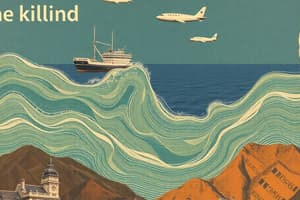Podcast
Questions and Answers
What causes the Coriolis Effect?
What causes the Coriolis Effect?
- Earth's rotating around the sun
- Gravity
- Earth's rotating on its axis (correct)
- Tides
In the northern hemisphere, the effect of Coriolis Force tends the water to move:
In the northern hemisphere, the effect of Coriolis Force tends the water to move:
- Horizontal
- Clockwise
- Vertical
- Counter clockwise (correct)
Why are surface currents at the surface of the ocean?
Why are surface currents at the surface of the ocean?
- Colder temperature (correct)
- Less salinity
- Warmer temperature and less salinity
- Colder temperature and more salinity
Which of the following instruments is used to determine the ocean's depth?
Which of the following instruments is used to determine the ocean's depth?
To measure the salinity of ocean water, a ______ should be used?
To measure the salinity of ocean water, a ______ should be used?
Which type of water does the California current (west coast) carry from Canada?
Which type of water does the California current (west coast) carry from Canada?
How do warm water currents affect coastal areas along which they flow?
How do warm water currents affect coastal areas along which they flow?
How can the strength of ocean currents be assessed during navigation?
How can the strength of ocean currents be assessed during navigation?
What causes vertical ocean currents?
What causes vertical ocean currents?
What is the main cause of global convection currents?
What is the main cause of global convection currents?
What drives thermohaline circulation in oceans?
What drives thermohaline circulation in oceans?
How are deep ocean currents formed?
How are deep ocean currents formed?
Which of the following does NOT control surface currents?
Which of the following does NOT control surface currents?
How do warm water currents affect the coastal areas along which they flow?
How do warm water currents affect the coastal areas along which they flow?
What causes vertical ocean currents?
What causes vertical ocean currents?
How would you assess a vessel's safe speed during navigation in shallow water?
How would you assess a vessel's safe speed during navigation in shallow water?
What is the current and what causes current to happen?
What is the current and what causes current to happen?
Which of the following is a FALSE statement?
Which of the following is a FALSE statement?
Flashcards are hidden until you start studying
Study Notes
Ocean Currents and Tides
- Surface currents can be controlled by global wind, Coriolis effect, and continental deflections.
- Warm water currents can create unusually warm climates for the latitude, make the coastal climate cooler than the inland climate, or create greater rainfall along the coast.
Assessing Safe Speed and Current Strength
- To assess vessel safe speed during navigation in shallow water, calculate the under keel clearance and adjust speed.
- To assess the strength of ocean current during navigation, use an echo sounder, observe ship speed, or observe wave patterns.
Causes of Ocean Currents
- Ocean currents can be caused by imbalance in mass distribution, winds, or the rotation of the earth.
- Vertical ocean currents can be caused by the temperature and salinity of ocean water.
Global Convection Currents and Thermohaline Circulation
- The main cause of global convection currents is the uneven heating of the earth by the sun.
- Thermohaline circulation is driven by differences in temperature and salinity.
Coriolis Effect and Ocean Currents
- The Coriolis effect is the apparent curving of the path of oceans and winds due to Earth's rotation.
- In the northern hemisphere, the Coriolis force tends to make water move clockwise.
Deep Ocean Currents and Wave Formation
- Deep ocean currents form when cold, dense water sinks and flows beneath warm ocean water.
- Waves in the ocean are formed by winds transferring energy to the water surface.
Tides
- Tides are caused by the gravitational pull of the sun and moon on the earth's oceans.
- To calculate the data of tides in a secondary port, apply the data of standard ports.
- The range of tide can be determined by subtracting the low water height from the high water height.
Measuring Ocean Depth and Salinity
- Echo sounders are used to determine the ocean's depth.
- Refractometers are used to measure the salinity of ocean water.
Studying That Suits You
Use AI to generate personalized quizzes and flashcards to suit your learning preferences.




